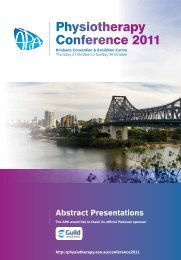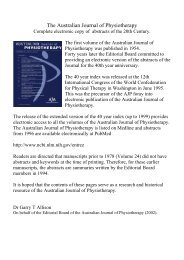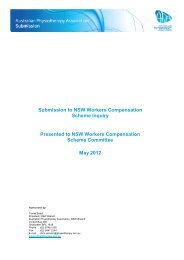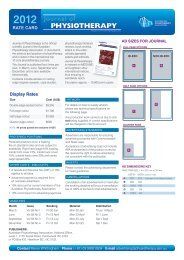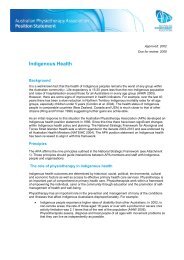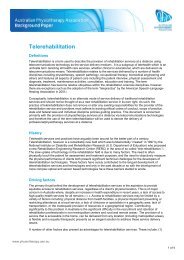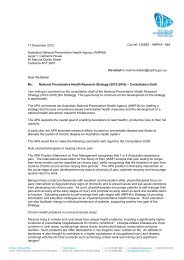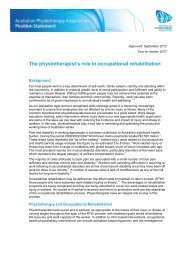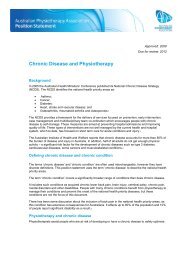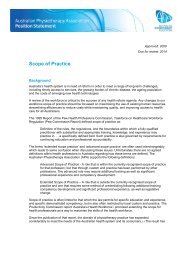2009 APA Conference Week Abstracts - Australian Physiotherapy ...
2009 APA Conference Week Abstracts - Australian Physiotherapy ...
2009 APA Conference Week Abstracts - Australian Physiotherapy ...
Create successful ePaper yourself
Turn your PDF publications into a flip-book with our unique Google optimized e-Paper software.
Animal <strong>Physiotherapy</strong> Group<br />
<strong>Physiotherapy</strong> in the small animal intensive<br />
care setting<br />
Nicholson HL<br />
The University of Queensland, Brisbane and Animal <strong>Physiotherapy</strong><br />
Services, Sydney<br />
This presentation will combine a summary of the PhD topic<br />
‘<strong>Physiotherapy</strong> in the canine intensive care setting’ with<br />
examples of the practical application of techniques on small<br />
animals, including a cat with laryngeal paralysis, a wombat<br />
with aspiration pneumonia, and a dog with tick (Ixodes<br />
holocyclus) poisoning. Topics discussed will include the<br />
causes, characteristics and risk factors for the survival of<br />
recumbency in dogs presenting to four veterinary referral<br />
hospitals in Sydney in a 12-month period, and a literature<br />
review of involuntary canine recumbency. The short-term<br />
effects of recumbency in dogs will be discussed and case<br />
studies of the administration of continuous positive airway<br />
pressure and manual chest physiotherapy will be presented.<br />
The session will conclude with recommendations for future<br />
research and an opportunity to ask questions.<br />
Advanced diagnostic imaging modalities in the horse:<br />
magnetic resonance imaging and nuclear scintigraphy<br />
Smith CL<br />
Veterinary Teaching Hospital Camden, University of Sydney, Camden<br />
Lameness in horses causes enormous economic losses<br />
within the equine industry and also has important animal<br />
welfare implications. New diagnostic imaging modalities<br />
including nuclear scintigraphy and magnetic resonance<br />
imaging can help identify the site and cause of difficult<br />
lameness problems in horses. Magnetic resonance imaging<br />
and nuclear scintigraphy has been a valuable diagnostic tool<br />
in human medicine for over 20 years and is now available<br />
in Australia in some equine veterinary clinics. Nuclear<br />
scintigraphy involves injecting a technetium-labeled<br />
radiopharmaceutical intravenously. A gamma camera then<br />
identifies sites of increased radioisotope uptake, which<br />
indicates active bone remodeling. It is of particular benefit<br />
in cases in which the lameness is difficult to localise, such as<br />
in the upper limb. MRI should be considered in horses that<br />
have a lameness that has been localised to a specific region<br />
but convention diagnostic techniques such as radiographs<br />
and ultrasound have failed to provide a definitive diagnosis.<br />
MR imaging is very sensitive and specific, and gives detailed<br />
information about both soft tissues and bones. Magnetic<br />
resonance imaging and nuclear scintigraphy can provide<br />
invaluable information in horses that have complicated<br />
lameness problems. A thorough clinical and lameness<br />
examination including diagnostic nerve blocks, radiographs<br />
and ultrasound is imperative to ensure case selection for<br />
MR Imaging or nuclear scintigraphy is optimal. Improving<br />
our ability to accurately pinpoint the cause of lameness will<br />
improve treatment and hopefully improve the prognosis for<br />
return to function in these horses.<br />
A randomised double-blind comparative study of<br />
the dorsal movement of the thorax relative to the<br />
scapula as achieved by four different<br />
physiotherapeutic techniques<br />
Steed C<br />
Topline <strong>Physiotherapy</strong><br />
Horses frequently incur injury around the scapulothoracic<br />
and shoulder regions. Shoulder lameness resistant to standard<br />
treatment and causing a loss of performance, particularly in<br />
high intensity stretch-shortening cycles (such as collection<br />
and jumping) may benefit from active assisted physiological<br />
mobilisations (AAPMs) of the scapulothoracic joint.<br />
Physiotherapists have long implemented such techniques<br />
in the management of human musculoskeletal disorders.<br />
Animal physiotherapists have applied these principles and<br />
use a variety of AAPM techniques to evaluate dysfunction<br />
and provide treatment. Despite clinical practice in animal<br />
physiotherapy, little research evidence exists in the equine<br />
field to support the efficacy of these techniques. Therefore,<br />
this study aims to evaluate the effectiveness of four different<br />
AAPMs in their ability to influence the motion of structures<br />
of the scapulothoracic region. Changes in the equine wither<br />
height was considered to reflect alterations of mobility of<br />
the scapulorthoracic complex. The four AAPM techniques<br />
evaluated were: Thoracic lift, Thoracic Rounding,<br />
Cervicothoracic Dorsoventral Flexion and Thoracolumbar<br />
Sacral Rounding. Twelve thoroughbred geldings aged<br />
between 7 and 15 years, reportedly over 15’3hh (160<br />
cm), and currently in work for at least 3 hours per week<br />
were randomly allocated to one of 4 groups. Each group<br />
received the techniques in a different order to control for<br />
training or stretching responses. The horse owner ensured<br />
square stance in the crush during each measurement. Two<br />
assistants measured wither height. The researcher applied<br />
the AAPM and was blind to the measures collected by<br />
the recording assistant. Each AAPM was measured twice.<br />
Results demonstrated a significant increase in wither height<br />
associated with both the Thoracic Lift and the Thoracic<br />
Rounding techniques, p < 0.01. These findings reveal two<br />
effective techniques for mobilisation of the scapulothroacic<br />
complex resulting in significant changes to equine wither<br />
height.<br />
Rehabilitation following traumatic cauda equina<br />
transection and sacral displacement in a young puppy:<br />
a year in review<br />
Steinman L<br />
Four Foot <strong>Physiotherapy</strong>/Capital Animal <strong>Physiotherapy</strong>, Canberra<br />
<strong>Physiotherapy</strong> is regularly used in neurological cases with<br />
good outcomes. This retrospective case study presents<br />
a Rhodesian ridgeback puppy, referred by its treating<br />
veterinarian for physiotherapy evaluation and treatment for<br />
a severe spinal injury. The injury was sustained 2 hours after<br />
birth when the puppy was bitten by his mother who was<br />
recovering from anaesthetic post caesarean. He presented at<br />
8 weeks, with bilateral hind limb paresis and LMN damage<br />
to bladder, perineum and tail indicating some complete<br />
cauda equina transection with other parts incompletely<br />
transected. Significant neurological compromise included<br />
absent reflexes (deep pain, withdrawal, patellar) left hind<br />
leg and severely reduced reflexes in right hind (slight deep<br />
pain and withdrawal, no patellar reflex). Radiographs<br />
showed a sacroiliac fracture and separation with ventral<br />
The e-AJP Vol 55: 4, Supplement 5



